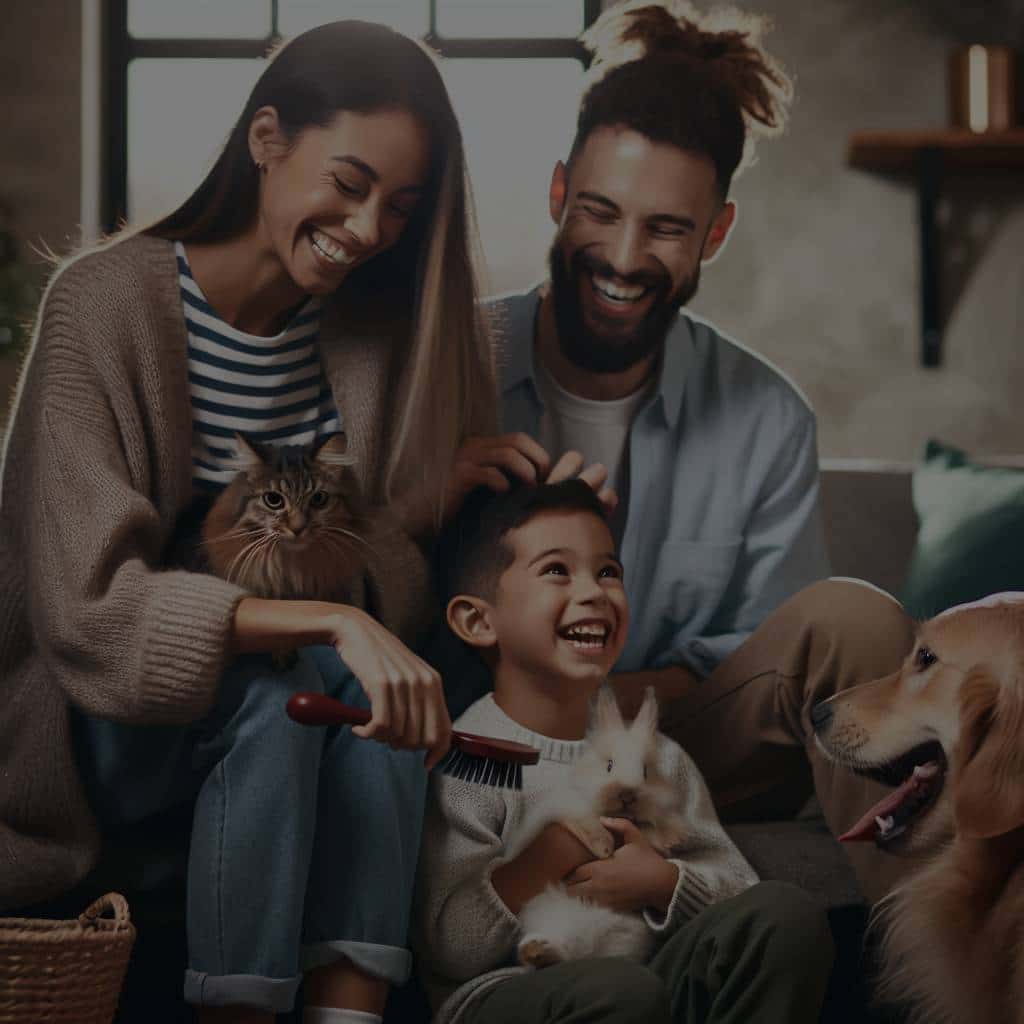What’s the Best Way to Enhance the Bond Between Siblings and Family Pets?

It’s no secret that pets have a special place in many family units, often bringing joy and companionship to children and parents alike. Their unwavering loyalty, boundless energy, and unconditional love are traits that many of us cherish. But what about the bond that children and pets share? Not just any children, but siblings? Undoubtedly, the relationship between siblings can be strengthened by a family pet. This article delves into the heart of the matter, exploring the best ways to nurture the bond between siblings and family pets.
Understanding Pets and Their Social Importance
Pets are more than just animals, they are an integral part of the family. Their importance is well-recognized in many households across the world. To begin with, it’s crucial to comprehend the social significance of pets and how they impact our everyday life.
Also to see : What’s the Best Way to Create a Dental Care Routine for Your Lizard?
Pets contribute to the social structure of a family in numerous ways. They provide comfort, companionship, and a sense of responsibility. A pet is an excellent way for siblings to learn about care and compassion, as they need to look after the animal together. This shared responsibility creates a common bond, fostering a sense of teamwork that can strengthen their relationship.
Dogs, cats, and other pets can also act as social catalysts, encouraging interaction and communication between family members. Their presence alone can be a conversation starter, promoting dialogue and creating opportunities for siblings to express their emotions and thoughts. This mutual love for the pet can help to enhance the bond between siblings.
Also read : What’s the Safest Method for Clipping the Nails of a Skittish Rabbit?
The Role of Parents in Fostering the Bond
Parents play a pivotal role in fostering the bond between their children and the family pet. It’s not enough to just introduce a pet into the family; parents need to guide their children in understanding the role pets play and how to properly care for them.
Firstly, parents should involve their children in the decision-making process when choosing a pet. Whether it’s a dog, cat, or a different kind of animal, it’s essential that the pet fits the family’s lifestyle. By involving kids in this process, parents can foster a sense of ownership and responsibility, paving the way for a stronger bond between siblings and the new family member.
Parents also need to model appropriate behaviour towards pets. This means showing respect, care, and love towards the animal. By treating the pet with kindness, parents set a positive example for their children to follow.
Activities to Encourage Interaction and Bonding
Activities that involve both siblings and the family pet can be extremely beneficial in enhancing their bond. These shared experiences can create lasting memories, and provide a sense of unity and teamwork.
A great activity to start with can be walking the dog. This not only encourages exercise for both kids and the pet, but also provides an opportunity for siblings to spend quality time together. During these walks, siblings can share responsibilities such as holding the leash or picking up after the dog.
Another effective bonding activity can be training sessions with the pet. Whether it’s teaching a dog new tricks or playing fetch, these activities encourage cooperation and communication between siblings. These interactions can lead to a greater understanding and respect for each other, enhancing their bond.
The Impact of Pets on Sibling Relationships
It’s important to understand the profound impact pets can have on the relationships between siblings. They provide a mutual interest and shared responsibility, which can foster cooperation and compassion.
Research has shown that pets can decrease tension and conflicts between siblings. The pet, essentially acts as a neutral party, diffusing potential arguments. Moreover, the shared responsibility of caring for a pet can help to reduce power imbalances between siblings, promoting equality and respect.
In conclusion, a family pet can significantly enhance the bond between siblings. Through shared responsibilities, common interests, and facilitated communication, pets provide numerous opportunities for siblings to grow closer. However, it’s important for parents to guide their children and model appropriate behaviour towards pets. With the right approach, the addition of a pet can bring immeasurable joy and unity to a family.
Assessing the Impact Over Time
Over time, the bond between siblings and their pet will deepen and evolve. This is a natural process, but it can be nurtured and guided in a positive direction. Observing the interactions between siblings and their pet can provide essential insights into the dynamics of their relationship.
Increasingly, children will learn to share responsibilities and make compromises for the sake of their pet. They will learn the importance of taking turns, working together, and communicating effectively. These are all valuable lessons that will not only enhance their bond with the pet, but also with each other.
Over time, the pet will also adapt to the family and form unique bonds with each member. This can bring about a sense of unity and cohesion within the family, strengthening relationships on all fronts.
In the end, enhancing the bond between siblings and family pets hinges on shared responsibilities, mutual respect, and effective communication. With the right approach, a pet can become a beloved family member, bringing siblings closer and fostering a loving and supportive home environment.
Animal Bond: The Role of Companion Animals in Development
Companion animals, such as dogs and cats, play a significant role in the development of children. By forging a bond between siblings and pets, families can foster traits like empathy, compassion, and responsibility among their children. Pets can actually assist in the psycho-social development of children, creating stronger bonds between family members.
The relationship between children and companion animals is unique, often characterized by deep emotional connections. Studies indicate that these relationships can serve as a crucial social support system for children, complementing their interactions with family members and peers. Pets can provide a form of companionship that is both comforting and non-judgmental, helping children to better understand and manage their emotions.
Moreover, pets can play a vital role in teaching children about coping strategies. Dealing with the inevitable challenges and hurdles that come with pet ownership, like illnesses and the pet’s eventual death, can help children develop resilience and learn how to cope with loss and grief. This also provides an opportunity for siblings to work together, strengthening their bond.
Littermate syndrome, a phenomenon seen in dogs where two siblings become overly dependent on each other, highlights the power of the animal bond. Although it is often seen as a problem in dog owners, it also underlines the deep connections that can form between animals, and by extension, the potential for a deep connection between children and their pets.
Ensuring that children understand the commitment involved in pet ownership, and are actively involved in caring for the pet, will not only make them responsible pet owners but also contribute to a stronger bond between siblings.
Conclusion: Emphasizing the Human-Animal Relationship in Families
The bond between children and pets is a beautiful and transformative relationship. When fostered properly, this bond can bring about remarkable changes not just in the children, but also in the dynamics of the family as a whole.
Longitudinal studies have shown that pets contribute to the overall psycho-social development of children, fostering empathy, responsibility, and emotional understanding. Pets also provide a valuable form of social support, easing stress and providing comfort in difficult times.
Moreover, the shared responsibility of pet care provides a platform for siblings to interact and collaborate in a positive and meaningful way. This interaction can lead to a stronger bond between siblings, reducing conflicts and power imbalances, and promoting equality and respect.
In conclusion, the human-animal relationship should be actively encouraged in families, for the multitude of benefits it can bring. From providing social support and companionship, to fostering a sense of responsibility and empathy, pets can significantly enhance the bond between siblings. It’s not just about bringing a pet into the family, but about nurturing this bond and ensuring that it develops in a positive and healthy way.
Ultimately, the presence of a pet in a family has the potential to bring about long-lasting and impactful changes, creating a loving, supportive, and harmonious home environment. It’s clear that when it comes to enhancing the bond between siblings, pets can be much more than just a furry friend—they can be a catalyst for unity, love, and understanding.
